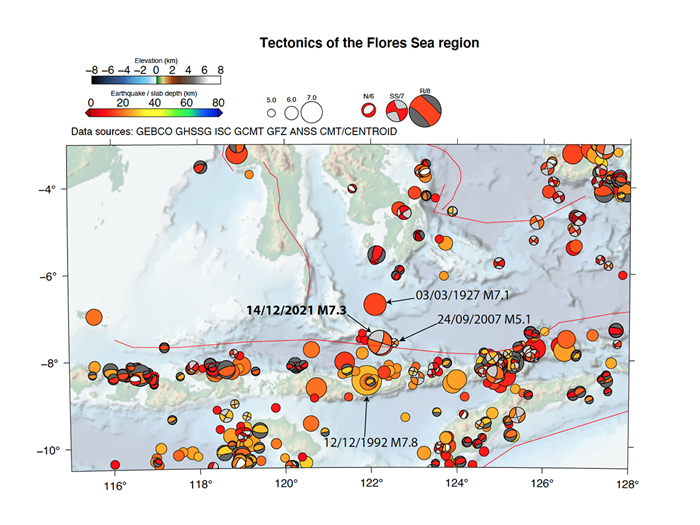A major earthquake struck off the coast of Indonesia in the Flores Sea on 14 December 2021 at approximately 11:20am (Singapore time). According to the United States Geological Survey, the magnitude-7.3 earthquake occurred off the north coast of Flores, about 110 kilometres (km) from Maumere, at a depth of 16 km. The Badan Meteorologi, Klimatologi, dan Geofisika (BMKG), the Indonesian meteorology, climatology, and geophysical agency, issued tsunami warnings for the region but no significant tsunami was detected.
The Flores Sea region is a seismically active region with complex tectonics because it lies at the junction of several tectonic plates including the Indo-Australian plate, the Sunda plate, and other small tectonic plates.
This Mw 7.3 earthquake is not a megathrust event at the plate boundary. It occurred on a strike-slip fault offshore of Flores. The blocks on each side of this fault slid past each other laterally but did not lead to strong elevation changes of the seafloor that could trigger large tsunamis.

Map showing the location of the 14 December 2021 Mw 7.3 earthquake, the local faults (red lines, from the GEM Global Active Faults Database), and the seismicity of the region with magnitude greater than 5 and shallower than 30 km. This map was produced using the ‘tectoplot’ code developed by Dr Kyle Bradley from EOS. (Source: Syed Idros and Karen Lythgoe/Earth Observatory of Singapore)
The location of the event suggests that the earthquake occurred on a fault that scientists had characterised as a dextral fault, where the block north of the fault moves to the right relative to the block south of the fault where Flores Island is located. This fault was mapped by the Earth Observatory of Singapore (EOS) and collaborators as part of a research project to understand the tectonics and the seismic hazard of the region.
"Earthquakes in this area are often associated with the Flores Thrust, however, this earthquake was on a strike-slip fault to the north," said Dr Karen Lythgoe, a Senior Research Fellow at EOS who studies the seismicity around Flores as part of her research in the Observational Seismology team. "Several smaller strike-slip earthquakes have occurred nearby before, including a Mw 5.1 strike-slip earthquake in September 2007," she added.
Earthquakes with magnitudes greater than 7 such as the 14 December event are not rare – they happen on average more than once a month worldwide. In the Flores Sea region, a large Mw 7.8 earthquake and tsunami occurred in December 1992 about 60 km south of the recent Mw 7.3 quake and caused severe damage in Flores. This Mw 7.3 earthquake is the largest event in the region since a much deeper Mw 7.9 earthquake happened in June 1996 on a different fault system about 50 km away to the northeast.
"This portion of Southeast Asia is tectonically complex, with myriad faults cutting across the landscape and seafloor. The earthquake of 14 December occurred on one of these faults," said Assistant Professor Aron Meltzner, a Principal Investigator at EOS who studies active tectonics and past sea levels in Southeast Asia. "Our research at EOS aims to better understand where these faults are and how and when they have ruptured in the past, in order to better quantify the seismic hazards in the region."
Assistant Professor Wang Yu of National Taiwan University contributed to this blog post.